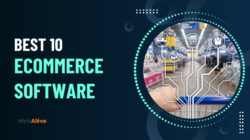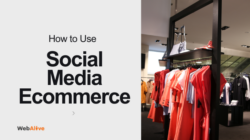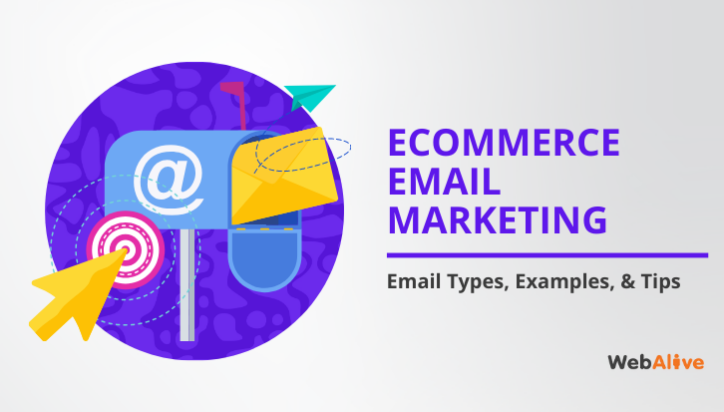
Ecommerce Email Marketing: Email Types, Examples, & Tips
For ecommerce businesses, email marketing is not just another strategy but a game changer!
In today’s crowded ecommerce landscape, amidst the bunch of proven digital marketing strategies, one method remains timeless, and that is email marketing.
In fact, 80% of small and medium-sized businesses consider email marketing their most crucial online tool for keeping customers engaged with their brand.
So, are you all set to discover the true potential of your ecommerce business through the power of email marketing? Here, we will walk you through the types of emails that you can send as an ecommerce store. But first, let’s find out why email marketing is an indispensable part of your ecommerce success.
What is the role of email marketing in ecommerce?
Direct communication
Email marketing provides a direct line of communication with your customers. Unlike social media or other, marketing emails go straight to your subscribers’ inboxes.
Customer retention
Retaining existing customers is much easier and cheaper than acquiring new ones. Email marketing allows you to stay in touch with past customers, keeping your brand top-of-mind and encouraging repeat purchases.
Personalisation
With email marketing, you can segment your audience based on their preferences, purchase history, and behaviour.
Automation
Email marketing platforms offer automation features that allow you to send timely and relevant emails based on triggers such as signups, purchases, or abandoned carts.
Drive sales
Email is an effective channel for promoting products, announcing sales, and offering exclusive discounts or promotions. You can drive sales and increase revenue by sending targeted offers to your subscribers.
Analytics and insights
Email marketing platforms provide valuable data and insights into your campaigns, such as open rates, click-through rates, and conversion rates.
So, all these are what make email marketing essential for success in today’s competitive landscape.
10 Types of Ecommerce Email Campaign
Selecting the right type of email is a key strategy to drive success. Explore these 10 email types to identify the ones that align best with your business objectives.
1. Welcome email
The first impression matters, and it is your welcome email that sets the tone for your entire customer relationship. With a 91.43% open rate, sending a welcome email is always a good idea. So, instead of settling for a dry signup confirmation, craft a purpose-driven email that excites new subscribers, motivates them to take action, and lays the foundation for a long-lasting connection.
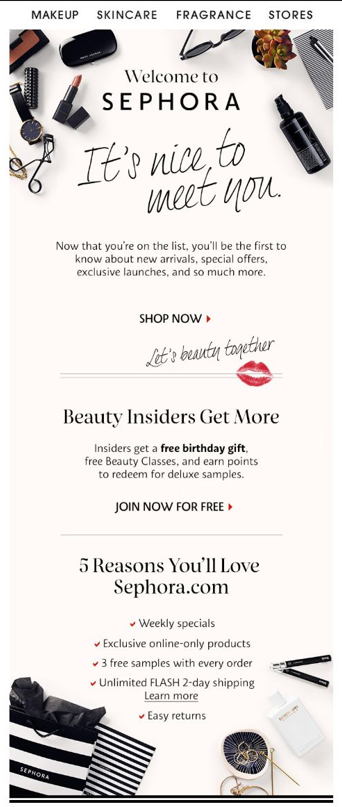
Some expert tips:
- Include a brief overview of the brand’s story, mission, or values to help new subscribers or customers understand what the brand stands for.
- Personalisation elements, such as using the recipient’s name or referencing their specific interests or preferences (if available), will make the welcome email feel more tailored and engaging.
- Add clear and compelling call to actions to prompt the recipient to take the next step, whether it’s exploring the website, making a purchase or following the brand on social media.
- Include information about upcoming promotions, product updates, or exclusive offers.
- Incorporate the brand’s logo, colours, and visual elements to reinforce brand identity and familiarity.
- The welcome email may invite recipients to connect with the brand on social media, join a loyalty program, or sign up for additional newsletters or updates.
2. Special discount or coupon email
Special discount or coupon emails are basically a targeted email marketing tactic used by ecommerce businesses to offer exclusive discounts, promotions, or coupons to their subscribers or customers. This type of email is designed to encourage recipients to make a purchase or take a specific action, such as visiting the website or signing up for a service, by providing them with an incentive in the form of a discount or coupon code.
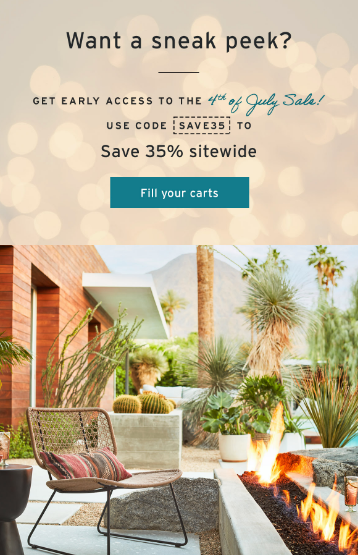
Some expert tips:
- The subject line has to be attention-grabbing enough to communicate the value proposition of the discount or coupon clearly.
- Personalising the email with the recipient’s name or past purchase history can make the offer feel more relevant and increase engagement.
- The email should have a clear and prominent call-to-action button or link that directs recipients to redeem the discount or coupon.
- Incorporate visually appealing images or graphics showcasing promoted products or services.
- Clearly outline the benefits of the discount or coupon, such as savings amount, percentage off, or free shipping.
- Specify a limited-time offer or limited availability of the discount or coupon to create a sense of urgency or scarcity.
3. Sales email
A sales email is a form of direct communication sent electronically, typically via email, with the primary goal of persuading recipients to take a specific action, usually making a purchase or engaging further with a product or service. These emails are a fundamental component of sales and marketing strategies for businesses across various industries, including ecommerce.
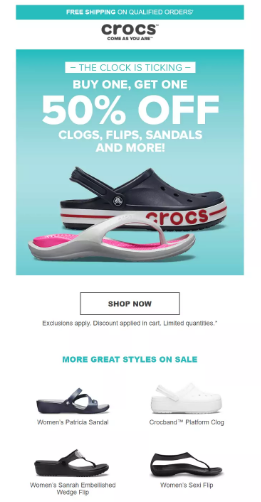
Some expert tips:
- The body of the email should highlight the benefits of the product or service, address the recipient’s needs or pain points, and include a clear call-to-action (CTA) prompting the recipient to take the desired action, such as making a purchase or visiting your ecommerce website.
- Including high-quality images or videos of the products can help grab the recipient’s attention and showcase their features and benefits.
- Incorporating customer testimonials, reviews, or case studies can help build credibility and trust in your brand and products.
- Ensure that your email is optimised for mobile devices, as many recipients may view it on smartphones or tablets.
- If the recipient doesn’t respond to the initial sales email, consider sending follow-up emails as part of a carefully crafted email sequence.
4. Transactional email
The main purpose of transactional emails is to provide essential information or updates regarding a customer’s interaction with your ecommerce platform. This could include order confirmations, shipping notifications, delivery updates, account notifications (e.g., password resets), or receipts.
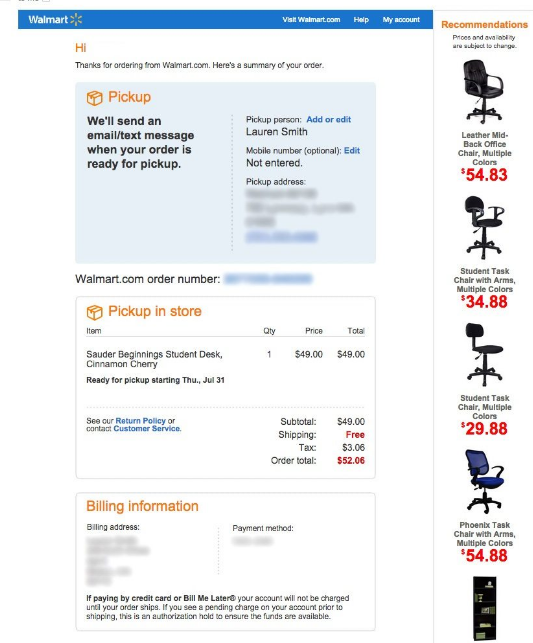
Some expert tips:
- Address the customer by name, referencing their recent purchase and providing relevant information tailored to their specific transaction.
- Sent immediately once a customer completes a purchase, confirming the details of their order, including the items purchased, pricing, shipping address, and estimated delivery date.
- Incorporating your brand’s logo, colours, and messaging ensures consistency and reinforces brand identity with each communication.
- Provide recipients with the ability to opt out of future communications and include necessary contact information.
- Include links to track the status of the order or contact customer support for assistance.
- Include subtle opportunities for upselling or cross-selling related products or services. For example, product recommendations in order confirmation emails can encourage additional purchases.
5. Loyalty program email
A loyalty program email is a communication sent to members of a loyalty program to keep them engaged, informed, and motivated to participate. These emails are tailored to members who have signed up for a loyalty program and often provide them with updates on their points balance, rewards earned, exclusive offers, and upcoming promotions.
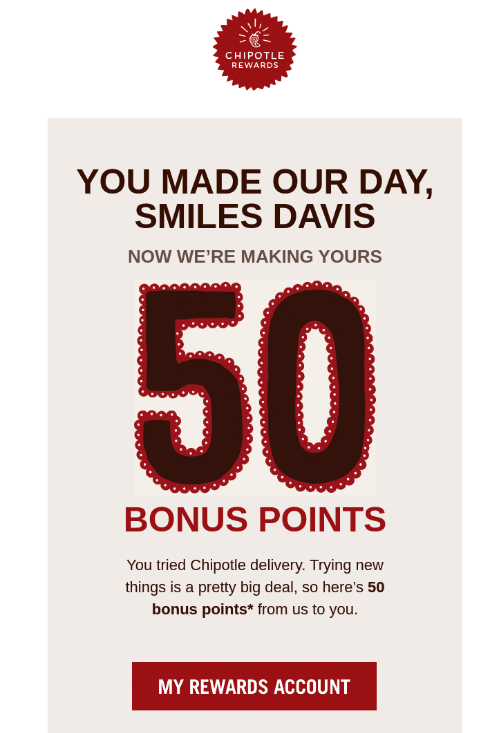
Some expert tips:
- Present the member’s current points balance to show them how close they are to unlocking rewards or reaching a higher tier within the program.
- Include exclusive offers or promotions that are available only to members. These offers can incentivise members to make additional purchases or engage further with the brand.
- Highlight upcoming events, sales, or promotions relevant to loyalty program members. This can create anticipation and encourage members to plan their purchases accordingly.
- Add calls to action to prompt members to take specific actions, such as purchasing, redeeming a reward, or referring friends to the program.
- You can also request feedback or surveys through loyalty program emails to gather insights into the member’s experience and preferences, helping the brand improve its program offerings.
6. Review request email
A review request email is a mail sent to customers once they have made a purchase, asking them to provide feedback or review about their experience with the product or service they purchased. The email is should be sent after the customer has received their order, giving them enough time to try out the product or service and form an opinion about. Otherwise, if you send the request too soon, it won’t allow the customer adequate time to evaluate their purchase.
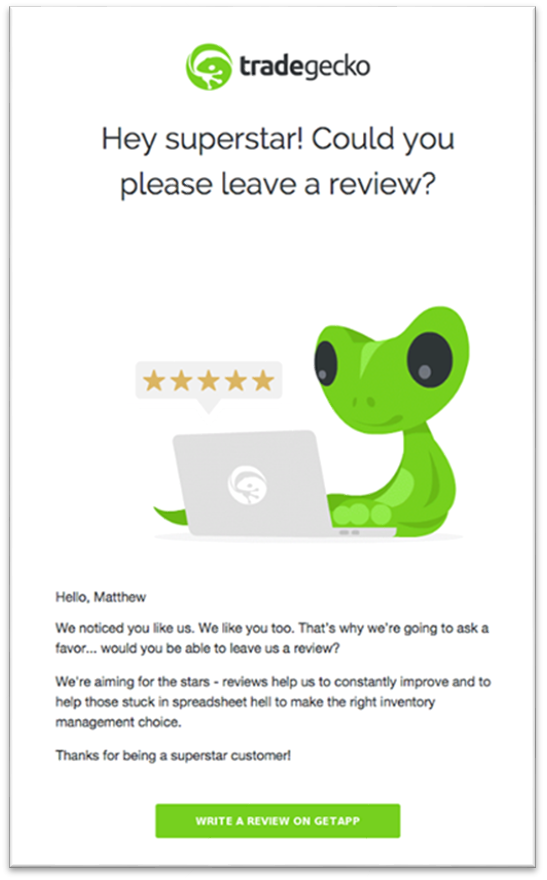
Some expert tips:
- Personalising the email with the customer’s name and purchase details helps make the request feel more genuine and relevant to the recipient.
- Include a clear and prominent call to action prompting the recipient to leave a review. This could be a button or a link directing them to the review platform, such as your website, social media page, or a third-party review site.
- The message should be concise, polite, and appreciative of the customer’s time and feedback by clearly explaining why their review is valuable to your business and how it can benefit other potential customers.
- If a customer doesn’t respond to the initial review request, consider sending a follow-up email as a gentle reminder. But be careful not to be too persistent or spammy, or this could annoy the customer.
7. New product launch email
This strategic communication email is sent to your email subscribers or customer base to announce the release of a new product or service. This type of email aims to generate excitement, build anticipation, and drive interest in the latest addition to your offerings.
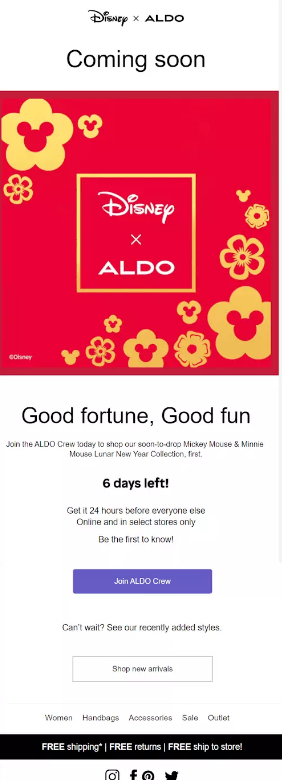
Some expert tips:
- Showcase the new product’s features, benefits, and unique selling points in the main body of the email.
- Use persuasive language and engaging visuals, such as images or videos, to highlight what makes the product special and why recipients should be excited about it.
- Provide information about when the new product will be available, whether immediately or on a specific launch date. Mention any relevant details about pricing, variations, or special offers associated with the launch.
- Incorporate social proof elements, like testimonials, reviews, or endorsements, to build credibility and reassure recipients about the quality and value of the new product.
- Consider offering exclusive discounts, early access, or special perks to email subscribers to reward their loyalty and encourage them to be among the first to try out the new product.
8. Cross-sell email
A cross-sell email is sent to existing customers with the aim of recommending complementary or related products to what they have previously purchased. The idea behind cross-selling is to increase the average order value by encouraging customers to buy additional items that enhance or supplement their original purchase.
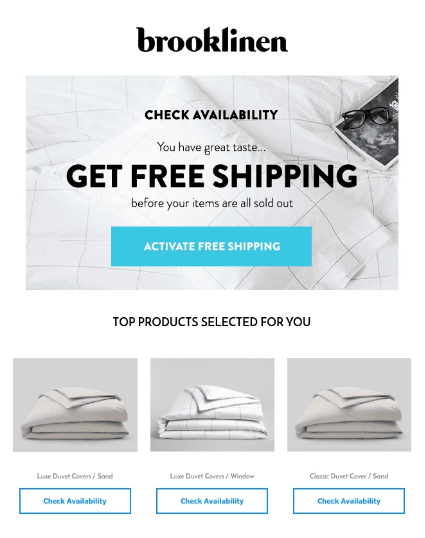
Some expert tips:
- Analyse customer purchase history and behaviour to identify potential cross-selling opportunities. For example, if a customer buys a camera, they might also be interested in accessories like lenses, tripods, or camera bags.
- Design your email that showcases these products in a visually appealing and persuasive manner, including images, descriptions, and links to the recommended products.
- Address the customer by name and reference their past purchases to make it feel tailored to their interests and preferences. Dynamic content can also automatically populate product recommendations based on the customer’s purchase history.
- Highlight the benefits of the recommended products and explain how they complement the customer’s previous purchase.
9. Win-back email
A win-back email is a type of marketing email sent to inactive customers (who may have previously made purchases but stopped interacting with your brand for a period of time) with the aim of re-engaging them and encouraging them to make a purchase or resuming their interaction with your brand.
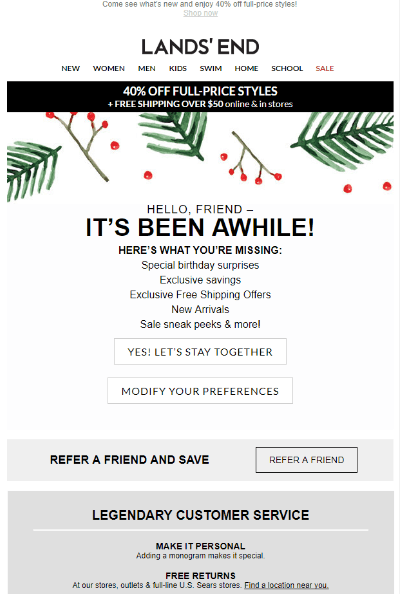
Some expert tips:
- Highlight new offerings, promotions, or updates to capture the attention of inactive customers and remind them of your products or services’ value proposition.
- Include a call-to-action (CTA) that prompts recipients to take a specific action. To encourage re-engagement, incentives like discounts or special offers can accompany this.
- Personalisation and tailored messaging can help make the email more relevant and resonate with recipients.
- You can include a feedback mechanism, such as a survey or link to leave feedback, to understand why customers have become inactive and gather insights to improve future marketing efforts.
- Send win-back emails at strategic intervals after a customer’s last interaction with your brand, such as a few weeks or months, to maximise the chances of re-engagement without being too intrusive.
10. Thank you email
A Thank You email is a gesture of appreciation sent to customers after they have completed a purchase, subscribed to a newsletter, participated in a promotion, or engaged with your brand in some other meaningful way.
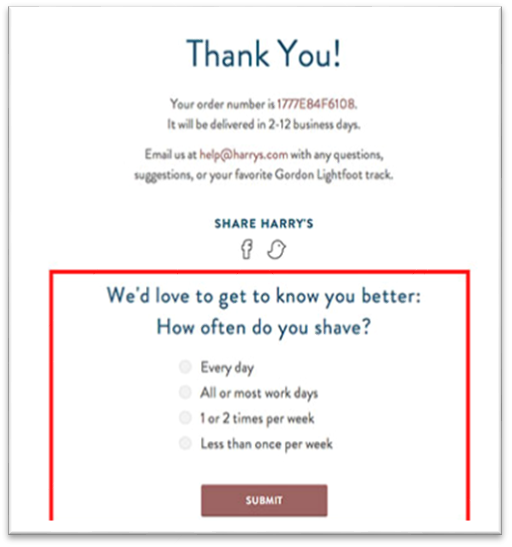
Some expert tips:
- Express genuine appreciation to the recipient for their action or engagement by acknowledging their support and contribution to your business.
- A thank you email confirms the customer’s action. For example, if it’s sent after a purchase, it confirms the details of the order, including the items bought, payment information, and delivery method.
- Personalise the thank you email with the customer’s name or details of their purchase to show that you value the individual customer and are not just sending out generic messages.
- You can use thank you emails to highlight what sets your brand apart, such as exceptional customer service, high-quality products, or a commitment to sustainability.
- Depending on the context, you can use a thank you email to solicit feedback from customers by asking them to share their thoughts on their purchase experience, product satisfaction, or suggestions for improvement.
Wrapping up
So, there you have it! Now, you are familiar with several types of emails that you can use as part of your strategy. Ecommerce email marketing shines in its ability to expand your customer base, drive email engagement through opens and clicks, and ultimately convert those interactions into sales. By mastering the mentioned tactics and best practices, it is time to unlock the full potential of your email marketing efforts.
You read a lot. We like that
Want to take your online business to the next level? Get the tips and insights that matter.
